MENA Region Renewable Energy: Saudi Arabia's Role and Future
VerifiedAdded on 2021/04/21
|7
|2125
|24
Report
AI Summary
This report analyzes the growing demand for energy in the MENA region, emphasizing the shift towards renewable energy sources. It highlights Saudi Arabia's significant potential in harnessing solar and wind energy, given its abundant desert regions and financial resources. The report discusses the depletion of non-renewable resources and the need for countries like Saudi Arabia to invest in renewable technologies to meet future energy needs. It also explores the challenges, including high technology costs, reliance on foreign expertise, and the need to balance investments in renewable energy with OPEC assignments. The report concludes that a well-balanced plan is crucial for the MENA region to secure its energy future, considering both renewable energy development and existing commitments, with Saudi Arabia playing a pivotal role. The report also includes a comprehensive list of references to support the analysis.
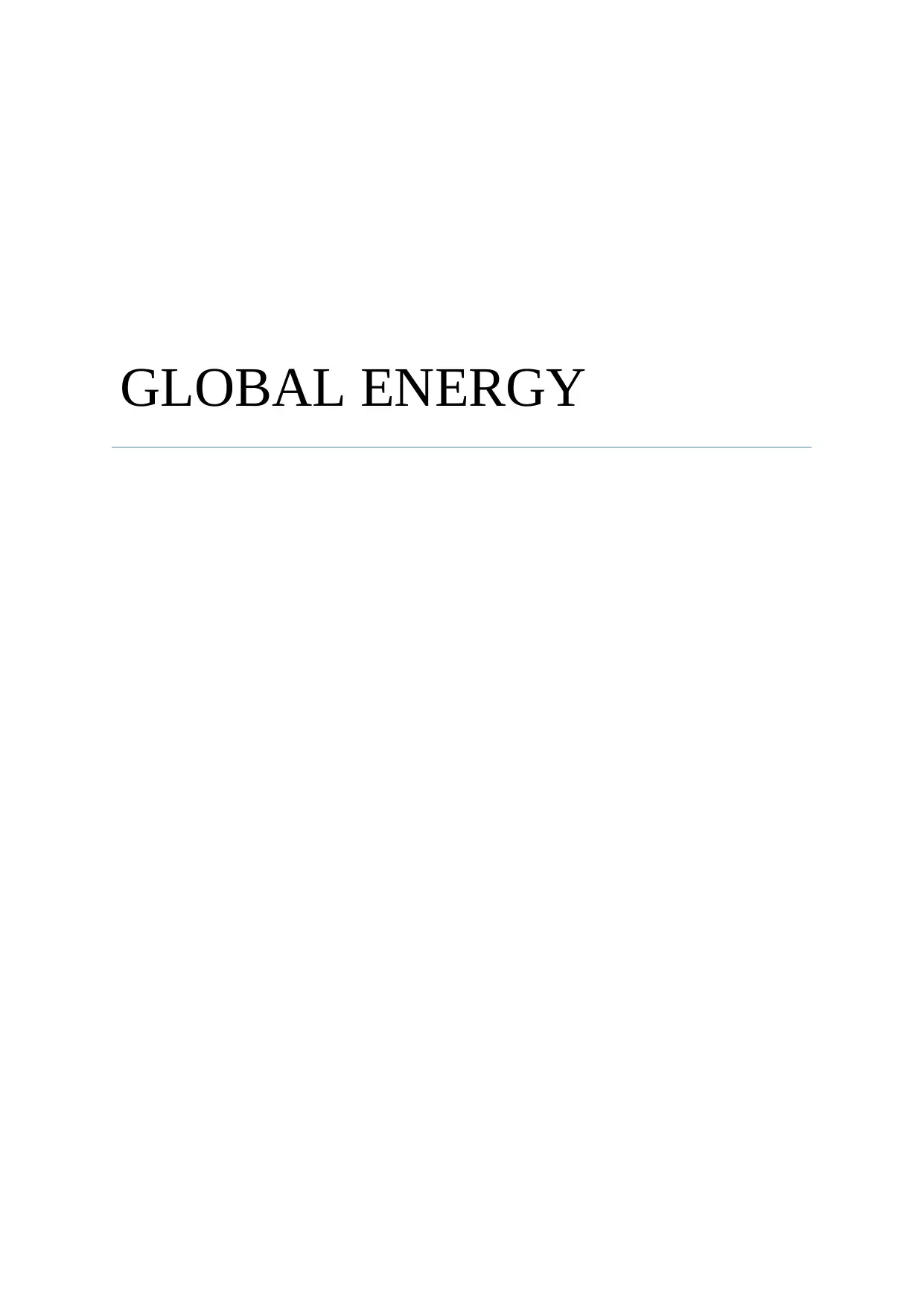
GLOBAL ENERGY
Paraphrase This Document
Need a fresh take? Get an instant paraphrase of this document with our AI Paraphraser
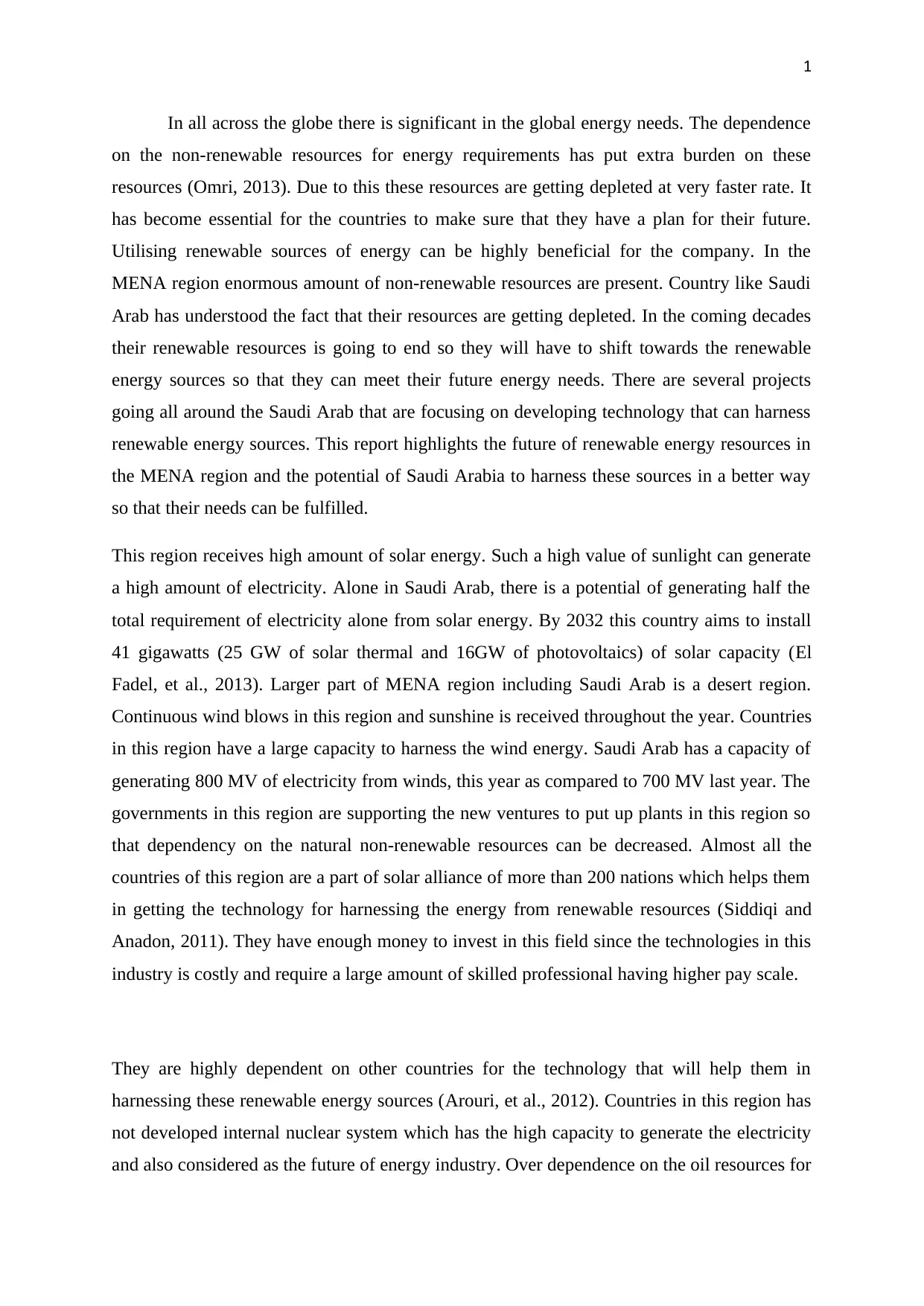
1
In all across the globe there is significant in the global energy needs. The dependence
on the non-renewable resources for energy requirements has put extra burden on these
resources (Omri, 2013). Due to this these resources are getting depleted at very faster rate. It
has become essential for the countries to make sure that they have a plan for their future.
Utilising renewable sources of energy can be highly beneficial for the company. In the
MENA region enormous amount of non-renewable resources are present. Country like Saudi
Arab has understood the fact that their resources are getting depleted. In the coming decades
their renewable resources is going to end so they will have to shift towards the renewable
energy sources so that they can meet their future energy needs. There are several projects
going all around the Saudi Arab that are focusing on developing technology that can harness
renewable energy sources. This report highlights the future of renewable energy resources in
the MENA region and the potential of Saudi Arabia to harness these sources in a better way
so that their needs can be fulfilled.
This region receives high amount of solar energy. Such a high value of sunlight can generate
a high amount of electricity. Alone in Saudi Arab, there is a potential of generating half the
total requirement of electricity alone from solar energy. By 2032 this country aims to install
41 gigawatts (25 GW of solar thermal and 16GW of photovoltaics) of solar capacity (El
Fadel, et al., 2013). Larger part of MENA region including Saudi Arab is a desert region.
Continuous wind blows in this region and sunshine is received throughout the year. Countries
in this region have a large capacity to harness the wind energy. Saudi Arab has a capacity of
generating 800 MV of electricity from winds, this year as compared to 700 MV last year. The
governments in this region are supporting the new ventures to put up plants in this region so
that dependency on the natural non-renewable resources can be decreased. Almost all the
countries of this region are a part of solar alliance of more than 200 nations which helps them
in getting the technology for harnessing the energy from renewable resources (Siddiqi and
Anadon, 2011). They have enough money to invest in this field since the technologies in this
industry is costly and require a large amount of skilled professional having higher pay scale.
They are highly dependent on other countries for the technology that will help them in
harnessing these renewable energy sources (Arouri, et al., 2012). Countries in this region has
not developed internal nuclear system which has the high capacity to generate the electricity
and also considered as the future of energy industry. Over dependence on the oil resources for
In all across the globe there is significant in the global energy needs. The dependence
on the non-renewable resources for energy requirements has put extra burden on these
resources (Omri, 2013). Due to this these resources are getting depleted at very faster rate. It
has become essential for the countries to make sure that they have a plan for their future.
Utilising renewable sources of energy can be highly beneficial for the company. In the
MENA region enormous amount of non-renewable resources are present. Country like Saudi
Arab has understood the fact that their resources are getting depleted. In the coming decades
their renewable resources is going to end so they will have to shift towards the renewable
energy sources so that they can meet their future energy needs. There are several projects
going all around the Saudi Arab that are focusing on developing technology that can harness
renewable energy sources. This report highlights the future of renewable energy resources in
the MENA region and the potential of Saudi Arabia to harness these sources in a better way
so that their needs can be fulfilled.
This region receives high amount of solar energy. Such a high value of sunlight can generate
a high amount of electricity. Alone in Saudi Arab, there is a potential of generating half the
total requirement of electricity alone from solar energy. By 2032 this country aims to install
41 gigawatts (25 GW of solar thermal and 16GW of photovoltaics) of solar capacity (El
Fadel, et al., 2013). Larger part of MENA region including Saudi Arab is a desert region.
Continuous wind blows in this region and sunshine is received throughout the year. Countries
in this region have a large capacity to harness the wind energy. Saudi Arab has a capacity of
generating 800 MV of electricity from winds, this year as compared to 700 MV last year. The
governments in this region are supporting the new ventures to put up plants in this region so
that dependency on the natural non-renewable resources can be decreased. Almost all the
countries of this region are a part of solar alliance of more than 200 nations which helps them
in getting the technology for harnessing the energy from renewable resources (Siddiqi and
Anadon, 2011). They have enough money to invest in this field since the technologies in this
industry is costly and require a large amount of skilled professional having higher pay scale.
They are highly dependent on other countries for the technology that will help them in
harnessing these renewable energy sources (Arouri, et al., 2012). Countries in this region has
not developed internal nuclear system which has the high capacity to generate the electricity
and also considered as the future of energy industry. Over dependence on the oil resources for
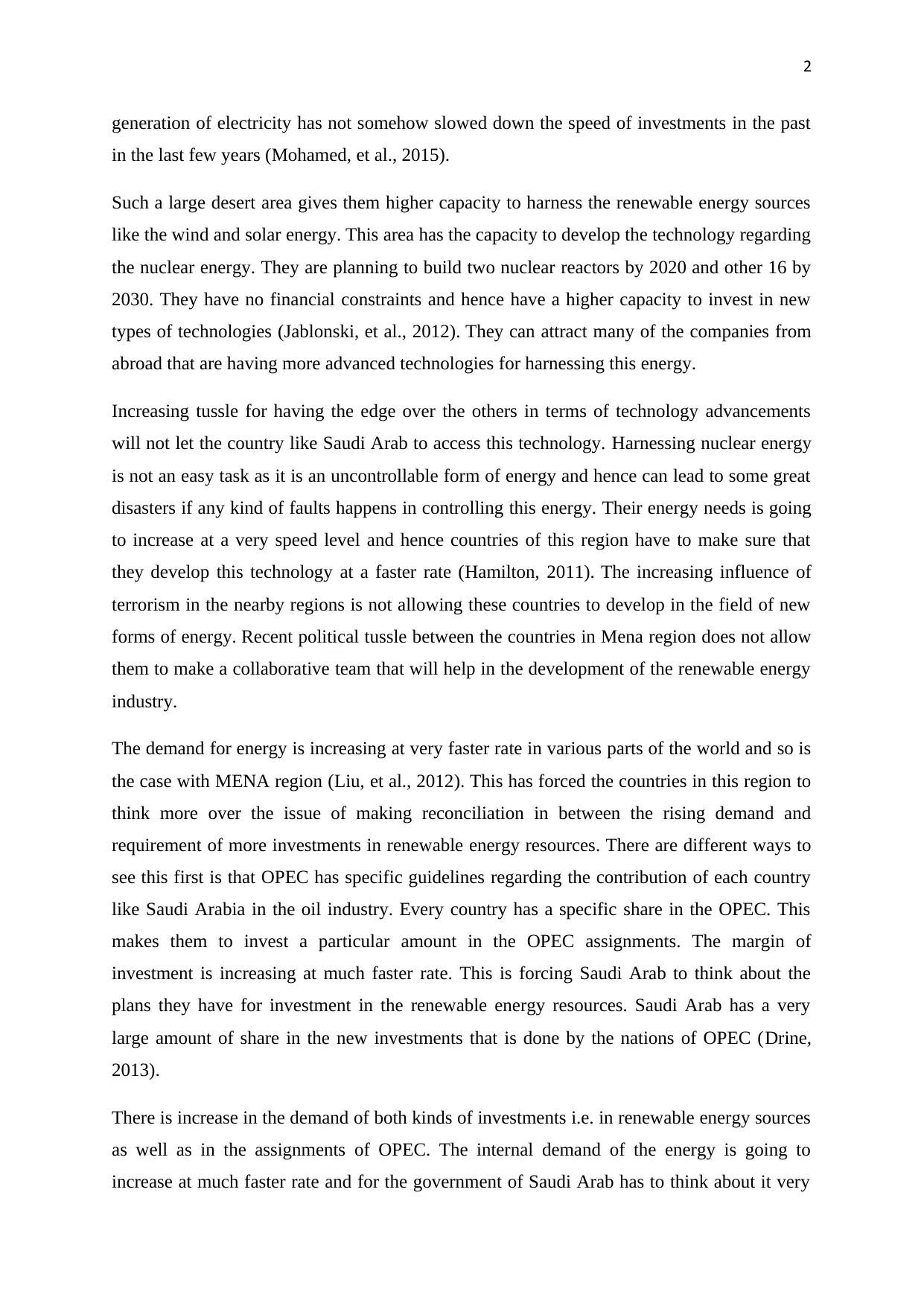
2
generation of electricity has not somehow slowed down the speed of investments in the past
in the last few years (Mohamed, et al., 2015).
Such a large desert area gives them higher capacity to harness the renewable energy sources
like the wind and solar energy. This area has the capacity to develop the technology regarding
the nuclear energy. They are planning to build two nuclear reactors by 2020 and other 16 by
2030. They have no financial constraints and hence have a higher capacity to invest in new
types of technologies (Jablonski, et al., 2012). They can attract many of the companies from
abroad that are having more advanced technologies for harnessing this energy.
Increasing tussle for having the edge over the others in terms of technology advancements
will not let the country like Saudi Arab to access this technology. Harnessing nuclear energy
is not an easy task as it is an uncontrollable form of energy and hence can lead to some great
disasters if any kind of faults happens in controlling this energy. Their energy needs is going
to increase at a very speed level and hence countries of this region have to make sure that
they develop this technology at a faster rate (Hamilton, 2011). The increasing influence of
terrorism in the nearby regions is not allowing these countries to develop in the field of new
forms of energy. Recent political tussle between the countries in Mena region does not allow
them to make a collaborative team that will help in the development of the renewable energy
industry.
The demand for energy is increasing at very faster rate in various parts of the world and so is
the case with MENA region (Liu, et al., 2012). This has forced the countries in this region to
think more over the issue of making reconciliation in between the rising demand and
requirement of more investments in renewable energy resources. There are different ways to
see this first is that OPEC has specific guidelines regarding the contribution of each country
like Saudi Arabia in the oil industry. Every country has a specific share in the OPEC. This
makes them to invest a particular amount in the OPEC assignments. The margin of
investment is increasing at much faster rate. This is forcing Saudi Arab to think about the
plans they have for investment in the renewable energy resources. Saudi Arab has a very
large amount of share in the new investments that is done by the nations of OPEC (Drine,
2013).
There is increase in the demand of both kinds of investments i.e. in renewable energy sources
as well as in the assignments of OPEC. The internal demand of the energy is going to
increase at much faster rate and for the government of Saudi Arab has to think about it very
generation of electricity has not somehow slowed down the speed of investments in the past
in the last few years (Mohamed, et al., 2015).
Such a large desert area gives them higher capacity to harness the renewable energy sources
like the wind and solar energy. This area has the capacity to develop the technology regarding
the nuclear energy. They are planning to build two nuclear reactors by 2020 and other 16 by
2030. They have no financial constraints and hence have a higher capacity to invest in new
types of technologies (Jablonski, et al., 2012). They can attract many of the companies from
abroad that are having more advanced technologies for harnessing this energy.
Increasing tussle for having the edge over the others in terms of technology advancements
will not let the country like Saudi Arab to access this technology. Harnessing nuclear energy
is not an easy task as it is an uncontrollable form of energy and hence can lead to some great
disasters if any kind of faults happens in controlling this energy. Their energy needs is going
to increase at a very speed level and hence countries of this region have to make sure that
they develop this technology at a faster rate (Hamilton, 2011). The increasing influence of
terrorism in the nearby regions is not allowing these countries to develop in the field of new
forms of energy. Recent political tussle between the countries in Mena region does not allow
them to make a collaborative team that will help in the development of the renewable energy
industry.
The demand for energy is increasing at very faster rate in various parts of the world and so is
the case with MENA region (Liu, et al., 2012). This has forced the countries in this region to
think more over the issue of making reconciliation in between the rising demand and
requirement of more investments in renewable energy resources. There are different ways to
see this first is that OPEC has specific guidelines regarding the contribution of each country
like Saudi Arabia in the oil industry. Every country has a specific share in the OPEC. This
makes them to invest a particular amount in the OPEC assignments. The margin of
investment is increasing at much faster rate. This is forcing Saudi Arab to think about the
plans they have for investment in the renewable energy resources. Saudi Arab has a very
large amount of share in the new investments that is done by the nations of OPEC (Drine,
2013).
There is increase in the demand of both kinds of investments i.e. in renewable energy sources
as well as in the assignments of OPEC. The internal demand of the energy is going to
increase at much faster rate and for the government of Saudi Arab has to think about it very
⊘ This is a preview!⊘
Do you want full access?
Subscribe today to unlock all pages.

Trusted by 1+ million students worldwide
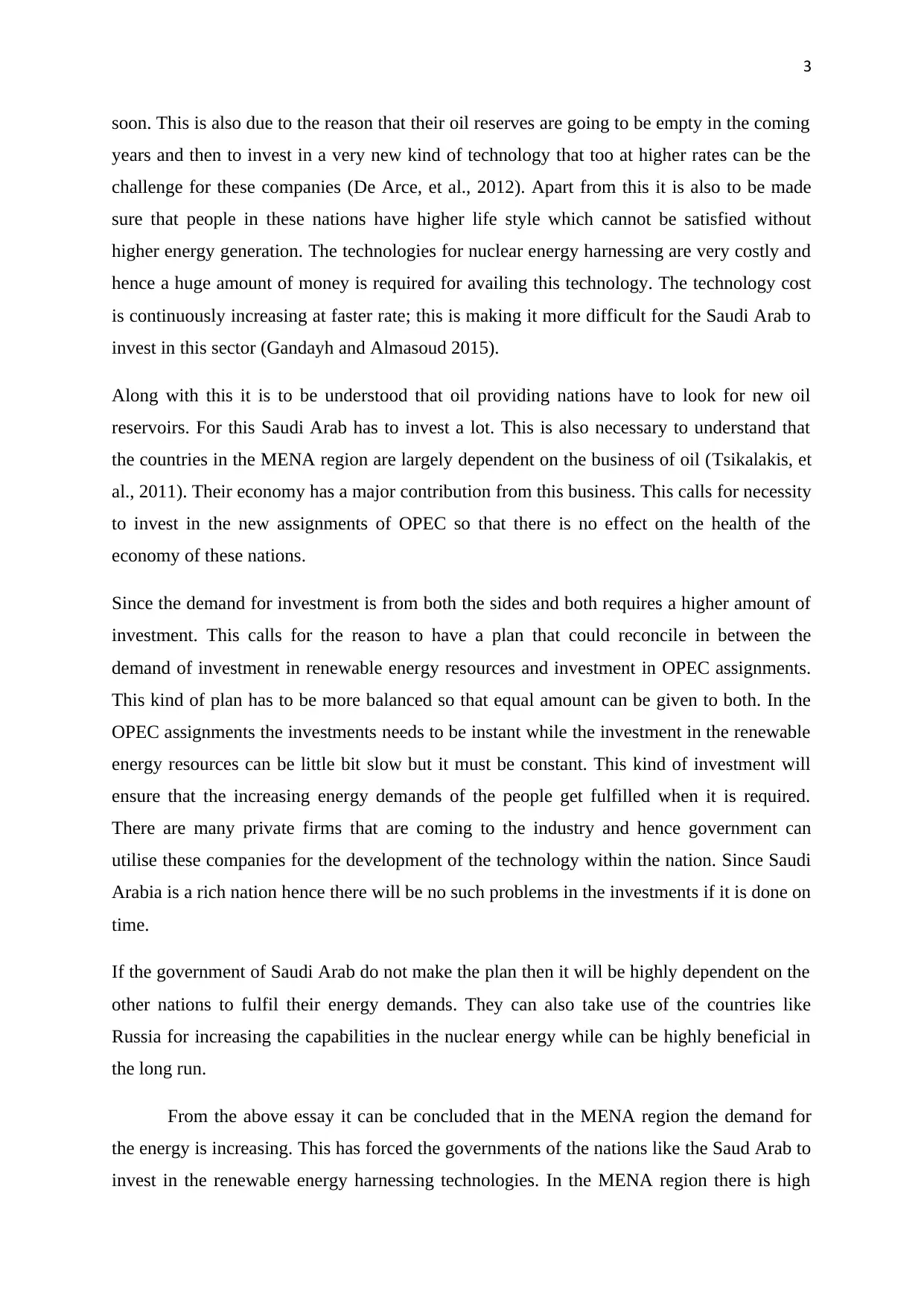
3
soon. This is also due to the reason that their oil reserves are going to be empty in the coming
years and then to invest in a very new kind of technology that too at higher rates can be the
challenge for these companies (De Arce, et al., 2012). Apart from this it is also to be made
sure that people in these nations have higher life style which cannot be satisfied without
higher energy generation. The technologies for nuclear energy harnessing are very costly and
hence a huge amount of money is required for availing this technology. The technology cost
is continuously increasing at faster rate; this is making it more difficult for the Saudi Arab to
invest in this sector (Gandayh and Almasoud 2015).
Along with this it is to be understood that oil providing nations have to look for new oil
reservoirs. For this Saudi Arab has to invest a lot. This is also necessary to understand that
the countries in the MENA region are largely dependent on the business of oil (Tsikalakis, et
al., 2011). Their economy has a major contribution from this business. This calls for necessity
to invest in the new assignments of OPEC so that there is no effect on the health of the
economy of these nations.
Since the demand for investment is from both the sides and both requires a higher amount of
investment. This calls for the reason to have a plan that could reconcile in between the
demand of investment in renewable energy resources and investment in OPEC assignments.
This kind of plan has to be more balanced so that equal amount can be given to both. In the
OPEC assignments the investments needs to be instant while the investment in the renewable
energy resources can be little bit slow but it must be constant. This kind of investment will
ensure that the increasing energy demands of the people get fulfilled when it is required.
There are many private firms that are coming to the industry and hence government can
utilise these companies for the development of the technology within the nation. Since Saudi
Arabia is a rich nation hence there will be no such problems in the investments if it is done on
time.
If the government of Saudi Arab do not make the plan then it will be highly dependent on the
other nations to fulfil their energy demands. They can also take use of the countries like
Russia for increasing the capabilities in the nuclear energy while can be highly beneficial in
the long run.
From the above essay it can be concluded that in the MENA region the demand for
the energy is increasing. This has forced the governments of the nations like the Saud Arab to
invest in the renewable energy harnessing technologies. In the MENA region there is high
soon. This is also due to the reason that their oil reserves are going to be empty in the coming
years and then to invest in a very new kind of technology that too at higher rates can be the
challenge for these companies (De Arce, et al., 2012). Apart from this it is also to be made
sure that people in these nations have higher life style which cannot be satisfied without
higher energy generation. The technologies for nuclear energy harnessing are very costly and
hence a huge amount of money is required for availing this technology. The technology cost
is continuously increasing at faster rate; this is making it more difficult for the Saudi Arab to
invest in this sector (Gandayh and Almasoud 2015).
Along with this it is to be understood that oil providing nations have to look for new oil
reservoirs. For this Saudi Arab has to invest a lot. This is also necessary to understand that
the countries in the MENA region are largely dependent on the business of oil (Tsikalakis, et
al., 2011). Their economy has a major contribution from this business. This calls for necessity
to invest in the new assignments of OPEC so that there is no effect on the health of the
economy of these nations.
Since the demand for investment is from both the sides and both requires a higher amount of
investment. This calls for the reason to have a plan that could reconcile in between the
demand of investment in renewable energy resources and investment in OPEC assignments.
This kind of plan has to be more balanced so that equal amount can be given to both. In the
OPEC assignments the investments needs to be instant while the investment in the renewable
energy resources can be little bit slow but it must be constant. This kind of investment will
ensure that the increasing energy demands of the people get fulfilled when it is required.
There are many private firms that are coming to the industry and hence government can
utilise these companies for the development of the technology within the nation. Since Saudi
Arabia is a rich nation hence there will be no such problems in the investments if it is done on
time.
If the government of Saudi Arab do not make the plan then it will be highly dependent on the
other nations to fulfil their energy demands. They can also take use of the countries like
Russia for increasing the capabilities in the nuclear energy while can be highly beneficial in
the long run.
From the above essay it can be concluded that in the MENA region the demand for
the energy is increasing. This has forced the governments of the nations like the Saud Arab to
invest in the renewable energy harnessing technologies. In the MENA region there is high
Paraphrase This Document
Need a fresh take? Get an instant paraphrase of this document with our AI Paraphraser
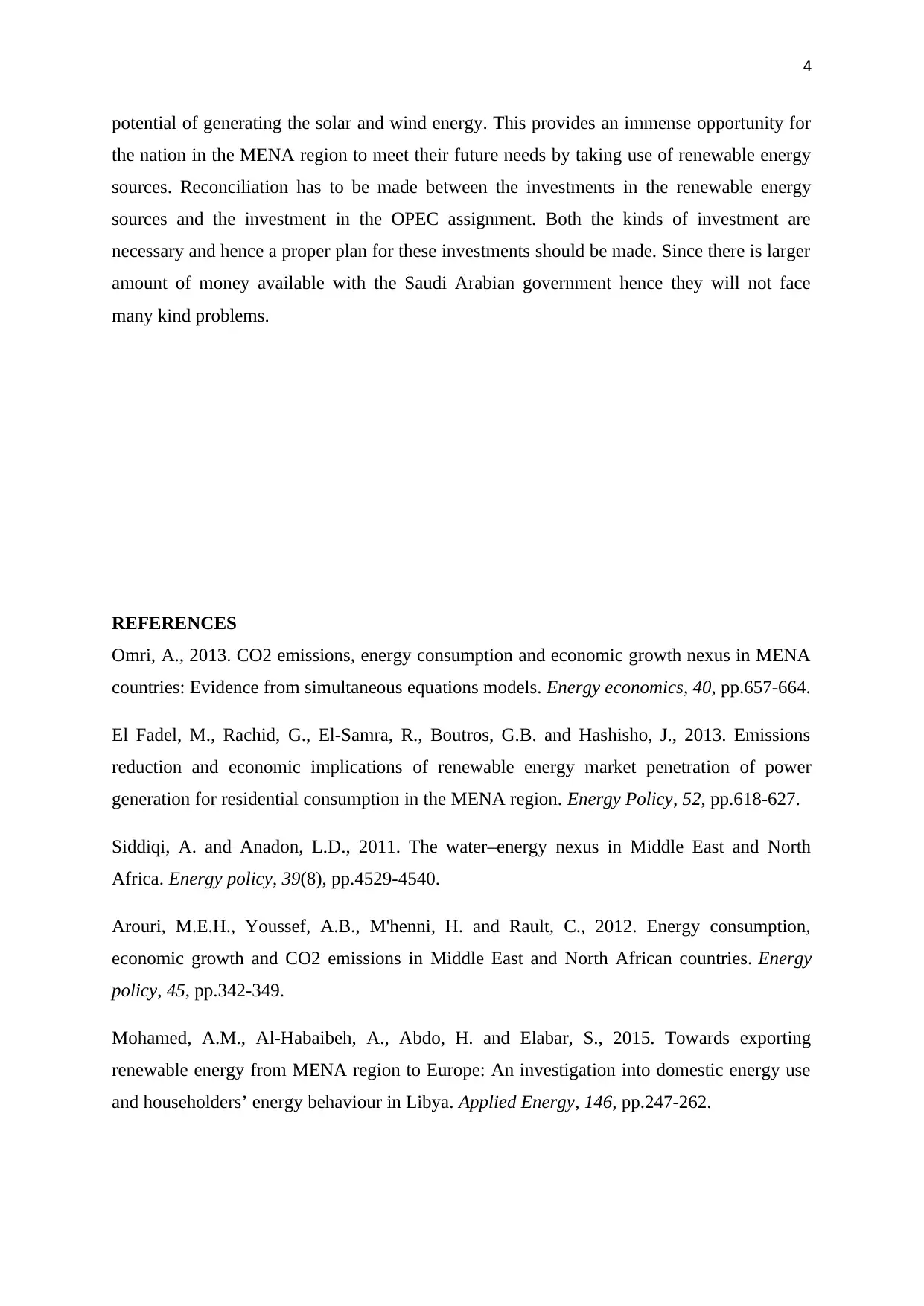
4
potential of generating the solar and wind energy. This provides an immense opportunity for
the nation in the MENA region to meet their future needs by taking use of renewable energy
sources. Reconciliation has to be made between the investments in the renewable energy
sources and the investment in the OPEC assignment. Both the kinds of investment are
necessary and hence a proper plan for these investments should be made. Since there is larger
amount of money available with the Saudi Arabian government hence they will not face
many kind problems.
REFERENCES
Omri, A., 2013. CO2 emissions, energy consumption and economic growth nexus in MENA
countries: Evidence from simultaneous equations models. Energy economics, 40, pp.657-664.
El Fadel, M., Rachid, G., El-Samra, R., Boutros, G.B. and Hashisho, J., 2013. Emissions
reduction and economic implications of renewable energy market penetration of power
generation for residential consumption in the MENA region. Energy Policy, 52, pp.618-627.
Siddiqi, A. and Anadon, L.D., 2011. The water–energy nexus in Middle East and North
Africa. Energy policy, 39(8), pp.4529-4540.
Arouri, M.E.H., Youssef, A.B., M'henni, H. and Rault, C., 2012. Energy consumption,
economic growth and CO2 emissions in Middle East and North African countries. Energy
policy, 45, pp.342-349.
Mohamed, A.M., Al-Habaibeh, A., Abdo, H. and Elabar, S., 2015. Towards exporting
renewable energy from MENA region to Europe: An investigation into domestic energy use
and householders’ energy behaviour in Libya. Applied Energy, 146, pp.247-262.
potential of generating the solar and wind energy. This provides an immense opportunity for
the nation in the MENA region to meet their future needs by taking use of renewable energy
sources. Reconciliation has to be made between the investments in the renewable energy
sources and the investment in the OPEC assignment. Both the kinds of investment are
necessary and hence a proper plan for these investments should be made. Since there is larger
amount of money available with the Saudi Arabian government hence they will not face
many kind problems.
REFERENCES
Omri, A., 2013. CO2 emissions, energy consumption and economic growth nexus in MENA
countries: Evidence from simultaneous equations models. Energy economics, 40, pp.657-664.
El Fadel, M., Rachid, G., El-Samra, R., Boutros, G.B. and Hashisho, J., 2013. Emissions
reduction and economic implications of renewable energy market penetration of power
generation for residential consumption in the MENA region. Energy Policy, 52, pp.618-627.
Siddiqi, A. and Anadon, L.D., 2011. The water–energy nexus in Middle East and North
Africa. Energy policy, 39(8), pp.4529-4540.
Arouri, M.E.H., Youssef, A.B., M'henni, H. and Rault, C., 2012. Energy consumption,
economic growth and CO2 emissions in Middle East and North African countries. Energy
policy, 45, pp.342-349.
Mohamed, A.M., Al-Habaibeh, A., Abdo, H. and Elabar, S., 2015. Towards exporting
renewable energy from MENA region to Europe: An investigation into domestic energy use
and householders’ energy behaviour in Libya. Applied Energy, 146, pp.247-262.
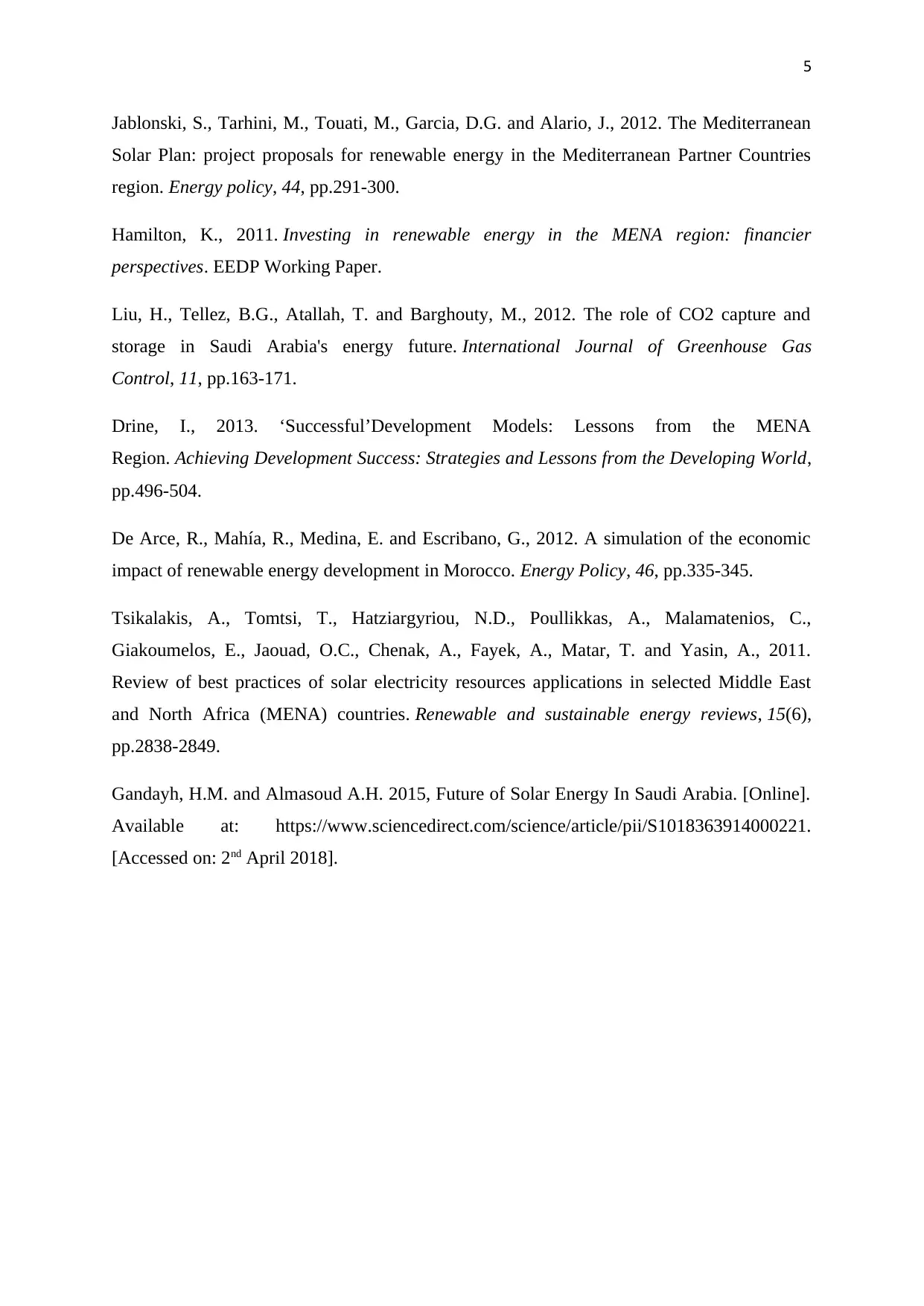
5
Jablonski, S., Tarhini, M., Touati, M., Garcia, D.G. and Alario, J., 2012. The Mediterranean
Solar Plan: project proposals for renewable energy in the Mediterranean Partner Countries
region. Energy policy, 44, pp.291-300.
Hamilton, K., 2011. Investing in renewable energy in the MENA region: financier
perspectives. EEDP Working Paper.
Liu, H., Tellez, B.G., Atallah, T. and Barghouty, M., 2012. The role of CO2 capture and
storage in Saudi Arabia's energy future. International Journal of Greenhouse Gas
Control, 11, pp.163-171.
Drine, I., 2013. ‘Successful’Development Models: Lessons from the MENA
Region. Achieving Development Success: Strategies and Lessons from the Developing World,
pp.496-504.
De Arce, R., Mahía, R., Medina, E. and Escribano, G., 2012. A simulation of the economic
impact of renewable energy development in Morocco. Energy Policy, 46, pp.335-345.
Tsikalakis, A., Tomtsi, T., Hatziargyriou, N.D., Poullikkas, A., Malamatenios, C.,
Giakoumelos, E., Jaouad, O.C., Chenak, A., Fayek, A., Matar, T. and Yasin, A., 2011.
Review of best practices of solar electricity resources applications in selected Middle East
and North Africa (MENA) countries. Renewable and sustainable energy reviews, 15(6),
pp.2838-2849.
Gandayh, H.M. and Almasoud A.H. 2015, Future of Solar Energy In Saudi Arabia. [Online].
Available at: https://www.sciencedirect.com/science/article/pii/S1018363914000221.
[Accessed on: 2nd April 2018].
Jablonski, S., Tarhini, M., Touati, M., Garcia, D.G. and Alario, J., 2012. The Mediterranean
Solar Plan: project proposals for renewable energy in the Mediterranean Partner Countries
region. Energy policy, 44, pp.291-300.
Hamilton, K., 2011. Investing in renewable energy in the MENA region: financier
perspectives. EEDP Working Paper.
Liu, H., Tellez, B.G., Atallah, T. and Barghouty, M., 2012. The role of CO2 capture and
storage in Saudi Arabia's energy future. International Journal of Greenhouse Gas
Control, 11, pp.163-171.
Drine, I., 2013. ‘Successful’Development Models: Lessons from the MENA
Region. Achieving Development Success: Strategies and Lessons from the Developing World,
pp.496-504.
De Arce, R., Mahía, R., Medina, E. and Escribano, G., 2012. A simulation of the economic
impact of renewable energy development in Morocco. Energy Policy, 46, pp.335-345.
Tsikalakis, A., Tomtsi, T., Hatziargyriou, N.D., Poullikkas, A., Malamatenios, C.,
Giakoumelos, E., Jaouad, O.C., Chenak, A., Fayek, A., Matar, T. and Yasin, A., 2011.
Review of best practices of solar electricity resources applications in selected Middle East
and North Africa (MENA) countries. Renewable and sustainable energy reviews, 15(6),
pp.2838-2849.
Gandayh, H.M. and Almasoud A.H. 2015, Future of Solar Energy In Saudi Arabia. [Online].
Available at: https://www.sciencedirect.com/science/article/pii/S1018363914000221.
[Accessed on: 2nd April 2018].
⊘ This is a preview!⊘
Do you want full access?
Subscribe today to unlock all pages.

Trusted by 1+ million students worldwide

6
1 out of 7
Related Documents
Your All-in-One AI-Powered Toolkit for Academic Success.
+13062052269
info@desklib.com
Available 24*7 on WhatsApp / Email
![[object Object]](/_next/static/media/star-bottom.7253800d.svg)
Unlock your academic potential
Copyright © 2020–2025 A2Z Services. All Rights Reserved. Developed and managed by ZUCOL.





